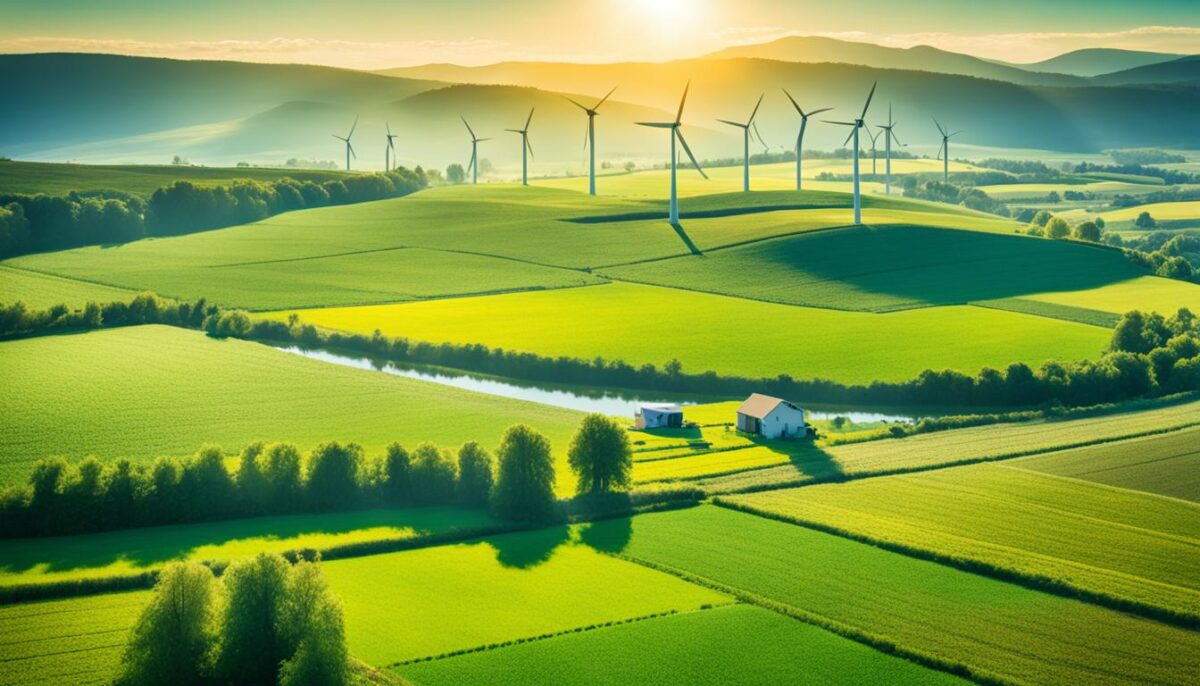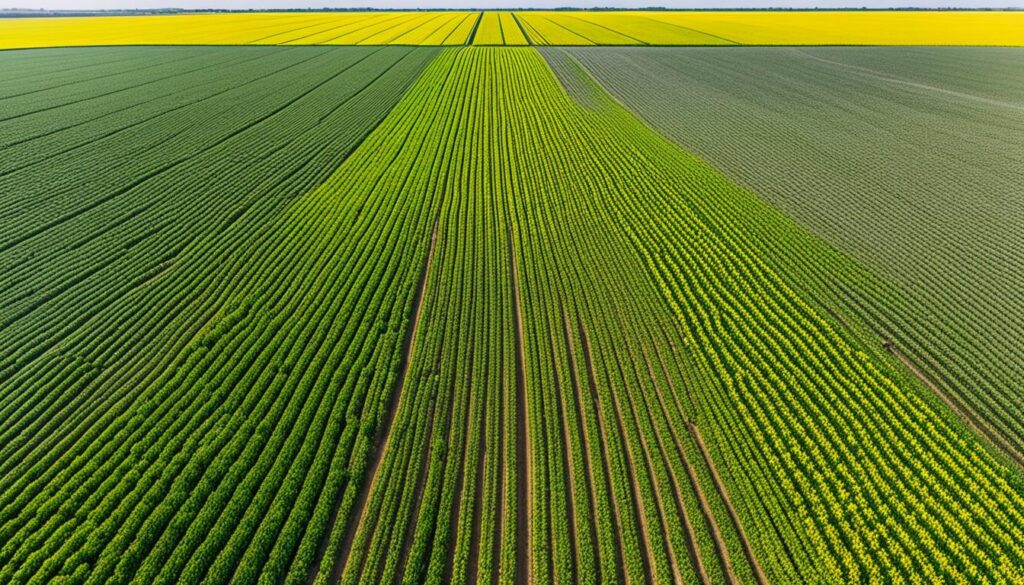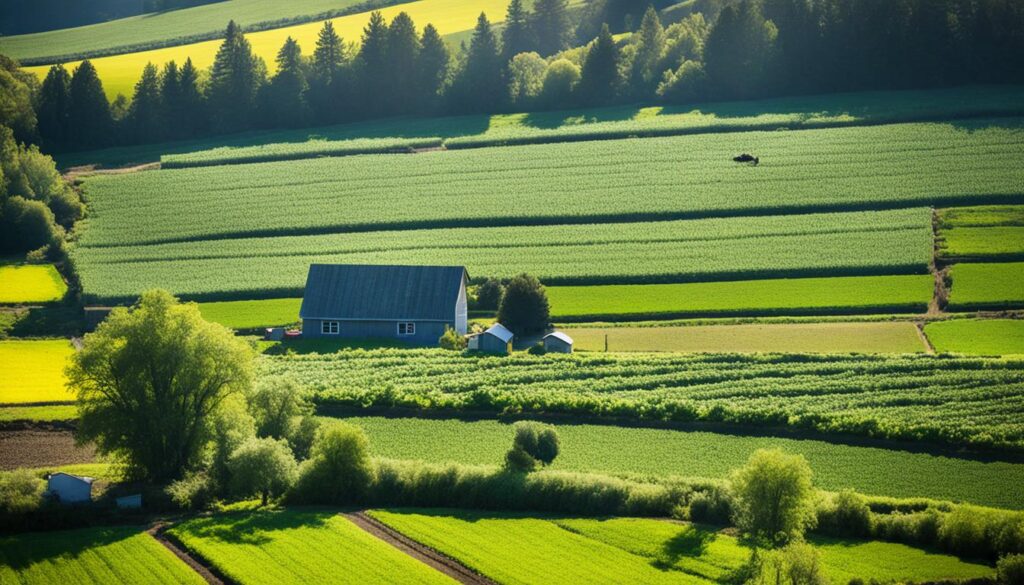In today’s world, climate change and a growing population challenge us every day. The solution might be found in sustainable agriculture. This way of producing food strives to keep a balance between saving the environment, making a profit, and being socially responsible. It could help make our food system stronger and kinder to our planet in the long run. This invites us to think: How does sustainable agriculture change the way we see farming?
Sustainable agriculture limits the use of man-made chemicals, supports biodiversity, and boosts the health of the soil.1 It uses techniques like managing pests without harmful chemicals, caring for the land to make it better, using technology more smartly, and getting communities involved. By doing all this, this method wants to make farming work together with nature. It does not just help the environment but also supports having food for a long time.1
Working with nature, not against it, is key in sustainable agriculture. When we find this balance, we can make a future that’s kinder to the earth. And have a continued supply of food.1 This piece will look into how sustainable agriculture can change our view of farming and the land, plus how it benefits everyone.
Key Takeaways
- Sustainable agriculture seeks to balance environmental preservation, economic viability, and social responsibility.
- Key principles include integrated pest management, regenerative farming practices, precision technology, and community engagement.
- Sustainable agriculture promotes biodiversity, enhances soil health, and minimizes the use of synthetic inputs.
- This holistic approach aims to create a more resilient and ecologically-sound food system.
- Cultivating the harmony between nature and agriculture can nurture a greener future and ensure long-term food supply sustainability.
Introduction to Sustainable Agriculture
Sustainable agriculture is a way of farming that aims to produce food now without harming the earth for later.2 It includes using methods that keep the soil healthy, save water, and protect nature.2
Defining Sustainable Agriculture
It’s an all-inclusive system that mixes different farming methods to make food in a way that’s good for nature and the economy.2 This way of farming highlights saving the environment, helping communities, and being able to feed ourselves without depending too much on others.
Importance in Today’s World
Today, the need for sustainable agriculture is more crucial than ever. It helps us deal with climate change, using up resources too quickly, and the need for more food.2 It’s a step towards creating a food supply that doesn’t harm the planet and can last for people in the future.
Challenges and Opportunities
The move to sustainable farming is not easy. It requires new tech, changing how farms work, and better rules to support it.2 Yet, this change can bring big benefits. It can make our world cleaner, help communities stay strong, and make sure we have enough food for a long time.2
Choosing sustainable farming means working towards a future where making food doesn’t hurt the planet but helps it thrive. It’s about making sure we can grow food while keeping our world healthy for the future.
Integrated Pest Management
Integrated Pest Management, or IPM, is a full approach to handling pests.3 It focuses on using natural processes more and less on man-made chemicals.4 An IPM plan uses different methods to keep pest numbers under control without harming crops or the world.4 IPM brings many good things. These are better care for the environment, less chemical harm, healthier crops, and safer communities and workers.5
Understanding Integrated Pest Management
The UC Statewide IPM Program describes IPM as a way to work with nature.3 It’s based on research done by UC scientists for more than fifty years.3 These scientists always update IPM with new findings and tech.3 They aim for farming that uses less pesticide yet deals well with pests.5
Benefits of IPM
IPM helps avoid too much harm from pests and cuts risks to health and the environment.4 It lowers the need for chemical pesticides, which is good for everyone.5 Good IPM plans look to the future, wanting to control pests better with fewer downsides.5
To make IPM work, we watch pest numbers, encourage their natural enemies, and choose eco-friendly ways to farm.3 The UC has lots of info on managing pests for more than 65 crops.3 Their website is full of tips on how to do IPM in agriculture the right way.3 This means focusing on stopping pests before they become a problem, using nature to keep them in check, and limiting chemical use.5
Using IPM means protecting farms and the environment.3 It means working with nature and paying close attention to pests.5
Regenerative Farming Practices
Regenerative farming is key in sustainable agriculture. It focuses on making the soil healthier, increasing biodiversity, and capturing carbon.6 Its core principles include caring for ecosystems, keeping soil healthy, using less man-made products, helping communities, and changing how we think about money.6 This approach leads to better soil and more life forms, less erosion, cleaner water, and farming that’s good for our planet. It also cuts costs on chemicals, provides more income sources, and boosts local jobs.6
Permaculture and Agroecology
Permaculture and agroecology are about working with nature, not against it.7 They aim to make farming part of a healthy ecosystem, long-term. This helps improve the soil and ecosystem health, reduce unfairness, and benefit kids in the future.6
Conservation Tillage
Practices like no-till or minimum-till save soil health and limit erosion.7 They work with nature, instead of fighting it. This means using less man-made stuff and relying more on natural ways for a strong, healthy food source.
Crop Rotation and Cover Crops
Crop rotation and cover crops are great for soil, push back weeds, and make ecosystems work better.7 Cover crops, in particular, help soils and offer more space for helpful insects.7 These methods help sustainable farmers grow food in ways that protect nature and make it stronger.
Sustainable Agriculture: Embrace Nature’s Harmony
Sustainable agriculture aims to make food production work with nature, not against it. This method reduces the use of harmful chemicals. Instead, it promotes practices that help the environment thrive.
By using natural ways to grow food, it supports a healthy balance in nature. This means more kinds of plants and animals can live and grow together.1
Such farming is good for the land and our future food supply. It’s a big change from how we used to farm. Now, we see the value of teaming up with nature. This approach is key to our sustainability and success.1
Reducing Chemical Dependence
Sustainable agriculture works to cut down on using harmful chemicals. It does so with methods like Integrated Pest Management (IPM).1
IPM focuses on natural ways to control pests and diseases. This means less harm to the soil and environment. It also helps keep farms safe for people working there.1
This approach leads to stronger and healthier farms. It makes sure our food is safe and the land stays fertile.1
Fostering Biodiversity
Sustainable agriculture values the variety of life. It knows diverse ecosystems are crucial.1
Through approaches like permaculture, it builds up the number of plants and animals. This makes the land and food supply more resilient.6
Protecting and enriching our environment is the heart of this farming. It secures food for the future while working with nature.1
Choosing sustainable farming means less harm to our planet. It’s a major change in how we grow food, focusing on nature’s solutions. This way, we can have reliable food systems for years to come.16
Precision Agriculture and Technology
Precision agriculture uses high-tech tools to better farming. It uses tools like GPS, sensors, and software to track and manage things like water and fertilizer.8 This makes farming more efficient, cuts waste, and helps the environment.9
This tech lets farmers be smarter about their land. They can make choices that waste less, saving money and being kind to the planet.8 It’s key for the future of farming, letting us take better care of our land and make a living.9
| Key Benefits of Precision Agriculture | Metrics |
|---|---|
| Increase in Crop Production | 4% increase8 |
| Improvement in Fertilizer Placement Efficiency | 7% increase8 |
| Reduction in Herbicide and Pesticide Use | 9% reduction8 |
| Reduction in Fossil Fuel Use | 6% reduction8 |
| Reduction in Water Use | 4% reduction8 |
| Cropland Avoided Due to Efficient Land Use | 2 million acres8 |
| Reduction in Herbicide Use | 30 million fewer pounds8 |
| Reduction in Fossil Fuel Use | 100 million fewer gallons8 |
| Water Savings | Enough to fill 750,000 Olympic-size swimming pools8 |
Precision agriculture is all about using resources wisely. By focusing on what the plants need, it uses less but produces more.9 This saves money and is better for the environment too. Techniques like VRT and soil mapping help farmers do this, saving costs and being more sustainable.9
This approach also protects the environment. It cuts down on harmful effects like pollution and soil erosion.9 Tools like GPS, drones, and sensors in precision ag are gentle on the land. They keep the ecosystem healthy for the long run.9
Using solar power in farming makes it more sustainable. Precision ag also uses smart tech for better crops.9 Devices like remote sensors and data analysts make farming more efficient and healthier.9
Farmers can stop pests and diseases early thanks to data. They also time their plantings and water use better.9 Precision ag helps make good farming decisions that save resources and boost success.9
This method is great for the soil and all living things on the farm. It helps them cope with climate change and other threats.9 Choosing precision farming is essential for long-lasting farming. It tackles big challenges like climate change, lack of resources, and more people to feed.9
Precision farming helps farmers deal with changing weather. They can still grow food even when things are unsure.9 Making smart farming choices now secures a good future in agriculture for the next generations.9
Community Engagement and Local Food Systems
Sustainable agriculture needs community engagement and local food systems to grow. Community Supported Agriculture (CSA) programs help by linking farmers and consumers. This builds a sense of shared care for the local food supply. Farmer’s markets and food hubs allow sustainable farmers to sell products closer to home. They do this by selling directly to the community, bridging the gap between farm and table. Also, initiatives like community gardens and rooftop farms in cities offer locally grown food.10 They improve food security and help people understand where their food comes from. By joining hands with the community, these farmers create strong and self-sufficient food systems. These systems meet the unique needs of their local areas.
Community Supported Agriculture
Community Supported Agriculture (CSA) programs are key to involving the community in local food. They connect consumers and farmers, letting them share in the food-growing journey. This way, people can enjoy fresh produce while learning about the hard work of sustainable farming. By supporting their local CSA, community members take an active role in the food they eat. This strengthens the connection between those who grow the food and those who enjoy it.11
Farmer’s Markets and Food Hubs
Farmer’s markets and food hubs help sell locally made, sustainable food. They provide a direct way for farms to connect with their local community. This means more of the earnings go to the farmers.11 Farmer’s markets also create a community vibe. People can meet the farmers, learn how food is grown, and build trust.11 These ways of selling food are crucial for strong local food systems that support sustainable farming.
Urban Agriculture Initiatives
Urban agriculture is growing food closer to where people live. This boosts community engagement and food security. City gardens and rooftop farms let residents help grow their own food.10 Besides easy access to fresh food, it teaches and excites people about sustainable farming. These projects blend food growing with city life. They connect people with the land and deepen an understanding of where our food comes from.
Organic Farming: A Sustainable Approach
Organic farming is a top-choice method in sustainable agriculture. It doesn’t use artificial fertilizers and pesticides. Instead, it employs natural techniques to keep soil healthy and pests in check.12
Principles of Organic Farming
This kind of farming looks at the big picture of farming. It focuses on rich biodiversity and recycling resources.12 By doing so, organic farming boosts the number of plant and butterfly species.12
At the same time, it cuts down on harmful greenhouse gases. This leads to a healthier environment compared to traditional farming.12
Organic Certification and Labeling
Organic farms undergo strict checks to be labeled as such.13 In October 2023, new rules for organic meat production were introduced. They set a bar for outdoor space, living situations, and how animals are transported.13
Choosing organic helps support a green food system. It’s a step towards a more earth-friendly way of producing food.
Policy and Regulations Supporting Sustainable Agriculture
The move to sustainable farming gets a big push from government policies and rules. Many steps like funding, tax breaks, and research help farmers and companies change to greener methods.14
Government Initiatives and Subsidies
Government programs and funding are key in making sustainable agriculture grow. They help more than just single farms, aiming to meet big environmental and social goals.14 Linking support to taking care of the earth is critical for a wide move to green farming.
Environmental Regulations and Standards
Rules on environment protection push and ensure greener farming through water, soil, and air protection.14 These laws and rules are building a farming future that is both sustainable and kind to the planet.
Economic Viability of Sustainable Practices
The economic worth of sustainable farm methods is key for farmers and others involved. First, using these practices might cost more. But, over time, a detailed look shows they bring in more money. This is because they can lower the costs, make soil healthier, and grow more crops. This makes the farm more profitable.15
Cost-Benefit Analysis
Looking at the costs and benefits is vital when talking about sustainable farming. Farmers who use these practices can save money. They spend less on fertilizers, pesticides, and water. Plus, they see better soil and more crop production. This makes their farms stronger and able to last longer.1516
Market Trends and Consumer Demand
People want food that’s made in a way that’s good for the earth and our health. This has made a big market for sustainable products.16 Farming and business that go for sustainable ways can make the most of these changing trends. They can make more money in the long run.16 Showing the financial gains from these methods helps push more people to use them. This way, more farms can be eco-friendly.17
| Sustainable Agriculture Practices | Economic Benefits |
|---|---|
| Integrated Pest Management (IPM) | Saves on costs, boosts crop quality, and makes work safer |
| Regenerative Farming (e.g., Permaculture, Agroecology) | Better soil, more crops, and ecosystems that last |
| Precision Agriculture Technology | Uses resources better, cuts waste, and makes farms more productive |
| Organic Farming | Can charge more, gets into a growing market, and lasts longer |
Conclusion
Sustainable agriculture is a big change in how we make food. Its goal is to work with nature, not against it.18 This technique keeps the soil healthy, saves resources, and helps many types of plants and animals live together.
It uses smart ways to control pests and grow food. Also, it involves the whole community in farming.19 These efforts are changing how we see farming and the food we eat.
With climate change and more people to feed, we need to act now. Sustainable agriculture is key to making sure we have food in the future.18 It helps us make a better world for everyone, without harming our planet’s balance.
This new way of farming joins our work with nature. It keeps the land healthy, saves things we need, and helps different plants and animals thrive.19 By coming up with new ideas and working together, those in sustainable agriculture are leading us to a better, safer food system.18
FAQ
What is sustainable agriculture?
Sustainable agriculture is about making food in ways that are good for our planet, our economy, and for everyone. It works by using less man-made stuff, encouraging a variety of life, and taking care of the ground.
Why is sustainable agriculture important in today’s world?
It’s crucial because we face big issues like changing climate, fewer resources, and more mouths to feed. This way of farming builds a system that can survive these challenges and feed us now and in the future.
What are the key principles of sustainable agriculture?
The main ideas include managing pests naturally, farming that heals the land, using technology carefully, and involving the community. These steps help keep the soil healthy, save resources, and encourage different kinds of plants and animals.
How does integrated pest management (IPM) contribute to sustainable agriculture?
IPM looks at the whole picture of pest control. It uses nature to fight pests and tries to not use too many chemicals. This protects crops and the environment, making farming more sustainable.
What are some regenerative farming practices in sustainable agriculture?
Methods like permaculture, agroecology, and certain ways of planting and rotating crops are part of regenerative farming. They make the soil better, increase the variety of life, and help lock away carbon.
How does sustainable agriculture harmonize with nature?
It aims to work with nature, not against it. By using less artificial products, supporting life variations, and allowing nature’s cycles to happen, farming becomes a partner with nature.
How does precision agriculture support sustainable agriculture?
Precision farming uses smart tools and data to farm more efficiently. It helps use resources better, cutting waste and the harm farming can do to the environment.
How does community engagement benefit sustainable agriculture?
Getting the community involved makes sustainable farming stronger. Programs like CSA and markets bring people and their food closer, making a more dependable food system.
What is the role of organic farming in sustainable agriculture?
Organic farming avoids man-made chemicals and focuses on a balanced ecosystem. It’s a key part of sustainable farming, giving consumers confidence through thorough checks and labels.
How do policies and regulations support the adoption of sustainable agriculture?
Governments help by offering money, tax breaks, and research help to move towards sustainable farming. Laws about the environment and farming encourage and ensure that steps are taken to be sustainable.
Is sustainable agriculture economically viable?
Yes, in the long run, it pays off. Doing things sustainably can cut costs, improve the land, and grow more food. Also, more people want to buy food grown this way, creating a good market.
Source Links
- https://www.linkedin.com/pulse/embracing-natures-harmony-profound-benefits-pest-rachael-harris
- https://s3.wp.wsu.edu/uploads/sites/2079/2015/06/Sustainable-Agriculture-An-Intoduction-ATTRA.pdf
- https://sarep.ucdavis.edu/sustainable-ag/ipm
- https://www.usda.gov/oce/pest/integrated-pest-management
- https://tracextech.com/integrated-pest-management-for-sustainable-agriculture/
- https://www.nrdc.org/stories/regenerative-agriculture-101
- https://www.suterra.com/blog/regenerative-vs.-sustainable-agriculture
- https://www.aem.org/news/the-environmental-benefits-of-precision-agriculture-quantified
- https://www.sustainableagriculture.eco/post/the-role-of-precision-agriculture-in-sustainable-farming-practices
- https://resources.depaul.edu/steans-center-community-based-service-learning/about/initiatives/sustainable-urban-food-systems/Pages/default.aspx
- https://dsi.aces.illinois.edu/making-the-case-for-local-food-systems-as-community-and-economic-development-lessons-from-central-illinois-local-food-projects/
- https://rjoas.com/issue-2022-10/article_03.pdf
- https://www.ciwf.com/media-and-news/blog/2024/04/growing-greener-organic-farming-vs-regenerative-agriculture
- https://www.nifa.usda.gov/grants/programs/sustainable-agriculture-programs
- https://www.usda.gov/oce/sustainability/spg-faqs
- https://sarep.ucdavis.edu/sustainable-ag
- https://sustainableagriculture.net/about-us/what-is-sustainable-ag/
- https://www.plugandplaytechcenter.com/resources/importance-sustainable-agriculture/
- https://www.sare.org/publications/systems-research-for-agriculture/conclusion/



